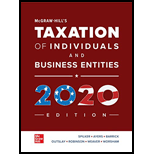
a.
Compute M’s after-tax
b.
Compute M’s after-tax cash flow from the entity’s business income and other forms of compensations if M received a salary of $100,000. Assume all the business income was allocated and distributed to M.
c.
Compute M’s after-tax cash flow from the entity’s business income and other forms of compensations if M received a salary of $20,000. Assume all the business income was allocated and distributed to M.
d.
Determine the compensation combination that generated the most after-cash flow for M. State the contributing factors that favoured this combination.
Trending nowThis is a popular solution!

Chapter 15 Solutions
MCGRAW-HILL'S TAX.OF INDIV.+BUS.2020
- Please explain the solution to this general accounting problem with accurate principles.arrow_forwardCarrington Trading is a merchandising company. Last month, the company's cost of goods sold was $72,800. The company's beginning merchandise inventory was $24,500, and its ending merchandise inventory was $21,300. What was the total amount of the company's merchandise purchases for the month?arrow_forwardPlease provide the answer to this general accounting question using the right approach.arrow_forward
- How is the cost of goods sold (COGS) calculated? Explanation.arrow_forwardDie Industries began operations on March 1 with cash of $150,000. All of March's $240,000 sales were on account. During March, no customer collections occurred. The cost of goods sold was $95,000, and there were no ending inventories or accounts payable. Use this information to determine the ending balance of cash on hand for March.arrow_forwardWhat is Redmont enterprise total equity ?arrow_forward





